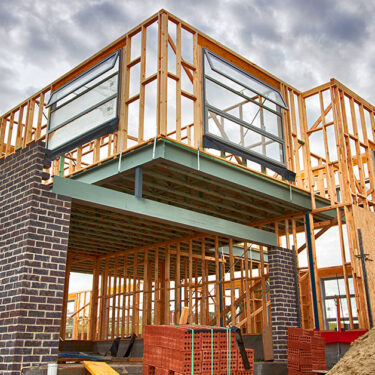In a lawsuit filed on August 11, the Barefoot Resort Residential Owners Association claimed experts found 13 construction defects in its $1.5 million beach cabana project. The North Myrtle Beach community’s homeowners association subsequently terminated contracts with the architect and general contractor, citing defects in design and construction that included the use of materials unsuitable for a coastal environment.
Five defendants involved in the new amenity center build were named in the suit: D3G Architects, Wingate Consulting Engineers, truss manufacturer UFP Mid-Atlantic, and general contractors JM Allen Construction and Excel Custom Builders. Construction began on the project in August 2019. In January, community association management company Ponderosa Management noted building hangers and truss plates used in the project were galvanized steel, rather than the stainless steel specified in project plans. Instead of replacing the materials, workers reportedly attempted to coat the galvanized steel to meet the specification.
“Even if specifications call for a certain type of material, a subcontractor may use substandard materials to cut costs,” said Michael Muglia, National Underwriting Director, Professional Liability, Burns & Wilcox, Detroit/Farmington Hills, Michigan. “Galvanized steel is a cheaper material, and using it in place of stainless steel is something that unfortunately happens all too often in construction.”
Design and construction errors are a common source of liability for architects, engineers and contractors, which is why insurance coverage such as Architects and Engineers Professional Liability Insurance and Contractors Professional Liability Insurance are imperative, Muglia said.
Rectify errors early to mitigate losses
An engineering firm hired to evaluate the Barefoot Resort and Golf beach cabana project determined that coated galvanized steel was not an acceptable equivalent to stainless steel, recommending the removal and replacement of all metal plate wood trusses, according to the lawsuit. The suit further alleged negligence, errors and omissions in the design and specifications for the project, as well as in the installation of improper laminated veneer lumber (LVL) beams, LVL ledger connectors, and incompatible masonry and concrete anchors, and in the construction and installation of concrete block columns.
The Barefoot Resort Residential Owners Association ultimately signed a new contract with a different architectural firm and is moving forward with the project in the midst of the litigation. Despite the added complexity, the situation could have been far worse had the cabana been finished using materials unsuited to its oceanside location, according to Muglia.
“Because of the potential for erosion, building with the wrong materials could lead to a total loss of a structure over time,” he said. “In the U.S., our insurance policies include rectification expense coverage for that exact reason. If a design or construction error is identified, the costs related to rectifying it before the building is completed can be covered.”
Because of the potential for erosion, building with the wrong materials could lead to a total loss of a structure over time. In the U.S., our insurance policies include rectification expense coverage for that exact reason.
A 2018 report found that U.S. construction professionals spend more than $177 billion per year on rework, conflict resolution and locating project data. While some project expenditures could be inevitable, those professionals could recoup the cost of replacing materials erroneously installed by a subcontractor under faulty workmanship coverage included in their Professional Liability Insurance policy, Muglia explained. Although faulty workmanship is excluded on many policies, it is included on Burns & Wilcox Professional Liability Insurance policies.
These professionals should also carry protective indemnity, which designates a separate limit to cover legal liability for subcontractors. ProConstruct, an exclusive Professional Liability Insurance program recently launched by Burns & Wilcox in the U.S., provides broad, customized coverage for contractors, engineers and other design professionals involved in construction and manufacturing. “This new offering for Contractors Professional Liability Insurance truly covers the bases for architects, engineers and contractors,” said Muglia.
With primary limits up to $5 million and excess limits up to $3 million, a ProConstruct policy includes coverage for bodily injury, property damage, pollution liability, and privacy liability, as well as other exposures.
Additionally, manufacturing companies—such as the truss manufacturer named in the Barefoot beach cabana lawsuit—should invest in appropriate Commercial General Liability (CGL) Insurance including Products/Completed Operations, Muglia said.
Lawsuits are common, expenses multiply quickly
The average cost of a lawsuit against an architect or engineer is $250,000, Muglia explained, though legal and settlement costs in some segments run much higher. Princeton University filed a $10.7 million lawsuit in December against Tod Williams Billie Tsien Architects and Jacobs Engineering Group, alleging breach of contract that included negligence in design and construction in building the university’s 129,000-square-foot Andlinger Center for Energy and the Environment, which was completed in 2016.
Uninsured costs related to litigation, especially those related to legal defense, often force businesses to file for bankruptcy protection.
“Legal defense costs can easily reach $500,000, even if the company is not negligent,” Muglia said. “If there is a lawsuit in construction, every entity involved in a project is named as a defendant. The cost of defending a lawsuit is substantial, even if a company has not been negligent and is found not liable for damages.”
If there is a lawsuit in construction, every entity involved in a project is named as a defendant. The cost of defending a lawsuit is substantial, even if a company has not been negligent and is found not liable for damages.
Water infiltration damage is one of the most common reasons lawsuits are filed against architects and engineers, according to Muglia. “An incorrect measurement made when building a roof, for example, could cause dips in that roof that collect pockets of water,” he said. These costs can add up on a large-scale project. “If a designer makes one small error in a subdivision with 100 houses built using the same design, remediating that small error becomes a significant expense.”
In March, KDA Architecture agreed to pay the Yakima School District a $1.7 million settlement for damage and repairs related to a blue wall installed at Eisenhower High School in Yakima, Washington. The wall, completed in 2013 as part of an $83 million campus rebuild, reportedly began taking on water, leading to the discovery of black mold, along with other significant damages. In December 2019, the city of Edmonton, Alberta filed an $8 million lawsuit against the architect and other developers of a new police campus that the city alleged had defects and deficiencies in design and construction that led to water infiltration and delayed the opening.
Officials in Fairfield County, South Carolina filed a lawsuit in February against an engineering firm and general contractor over a large infrastructure project allegedly marred by design and construction defects that included failed roads and bridges. Lawsuits over large infrastructure projects are on the rise, Muglia said.
Customized coverage, quality assurance and strong contracts are vital
Professional Liability Insurance policies for architects and engineers differ greatly and depend on the needs of each individual business. There is no standard language for the policy, Muglia said.
“In Professional Liability Insurance in general and especially with architects and engineers, every policy’s language is different,” he said. “It is vitally important for architects and engineers to work with an experienced insurance broker—first to identify coverage needs and then to make sure the policy matches those needs.”
It is vitally important for architects and engineers to work with an experienced insurance broker—first to identify coverage needs and then to make sure the policy matches those needs.
A study conducted by IBACOS, a scientific research and development company specializing in the construction industry, calculated that home builders that invest in specific quality assurance metrics could realize a 600 return on their investment and save an average $7,250 per home rather than spending an average $22,278 per home on warranty work and litigation. Home builders that define quality expectations for themselves and their crews can increase profits and decrease problems on projects, according to one IBACOS expert.
Strong contracts are a critical part of risk management for architects and engineers, particularly during the COVID-19 pandemic when state orders and supply chain issues could affect project progress.
Although construction demand may be strong, project delays or cancellations were commonplace amid stay-at-home orders earlier this year, with two-thirds of U.S. contractors surveyed in May reporting disrupted and delayed projects. In June, a survey by Canada’s Building Industry and Land Development Association showed a majority of Toronto, Ontario-area residential construction projects had been delayed due to the pandemic.
“Construction was stopped in many areas for an extended period,” Muglia said. “Architects, engineers and contractors should make sure their contracts include a force majeure clause that frees them from responsibility for project delays outside of their control, such as those that are the result of a pandemic.”
Maintaining insurance coverage is equally important, even for a business struggling during the current economic downturn. “A lawsuit for a defect in design or construction can be filed many years after a project is completed,” Muglia said. “Once a Professional Liability Insurance policy is dropped, retroactive coverage for costs related to past acts is no longer available. As long as the policy is maintained, costs related to past acts are covered.”








